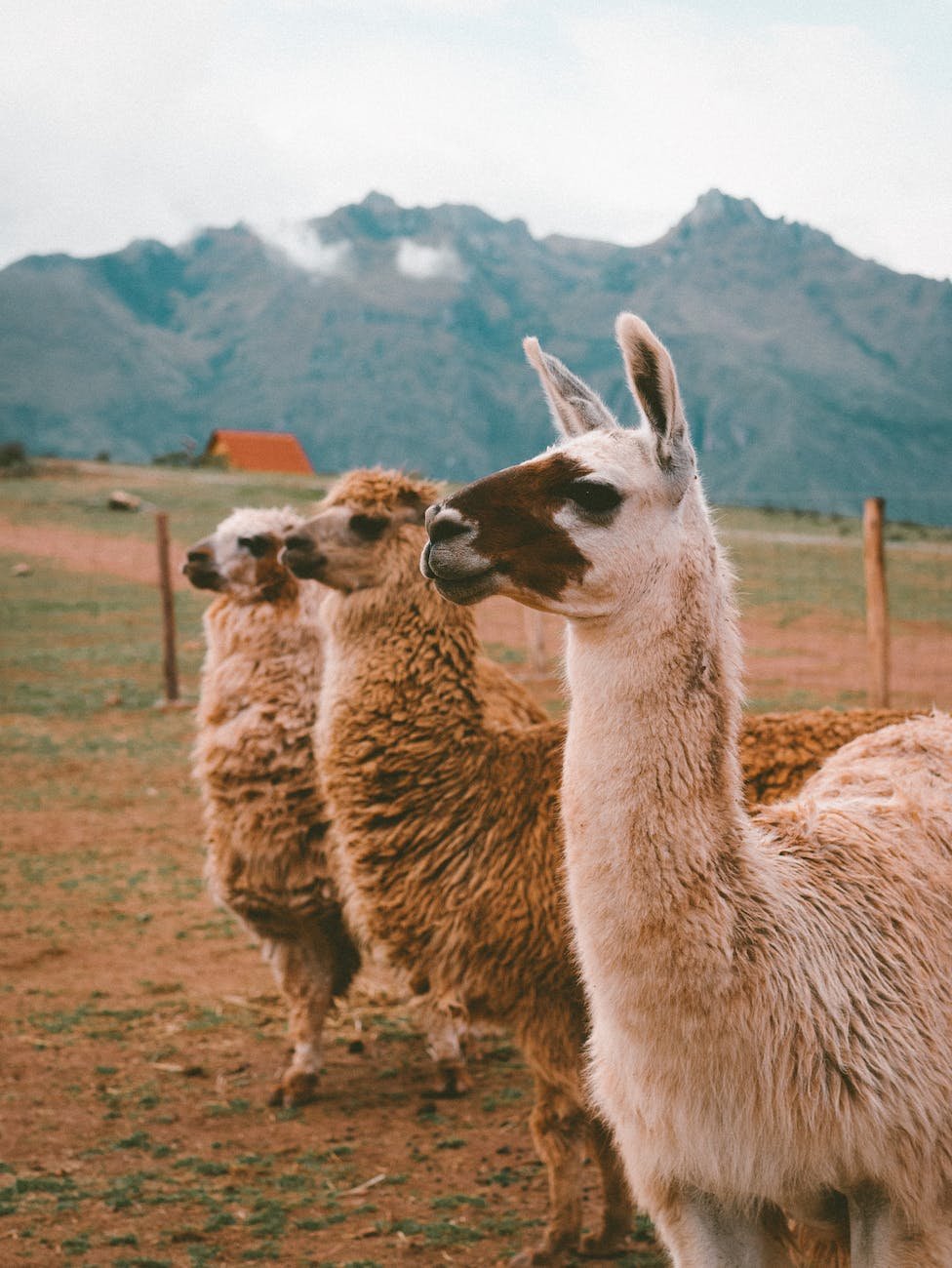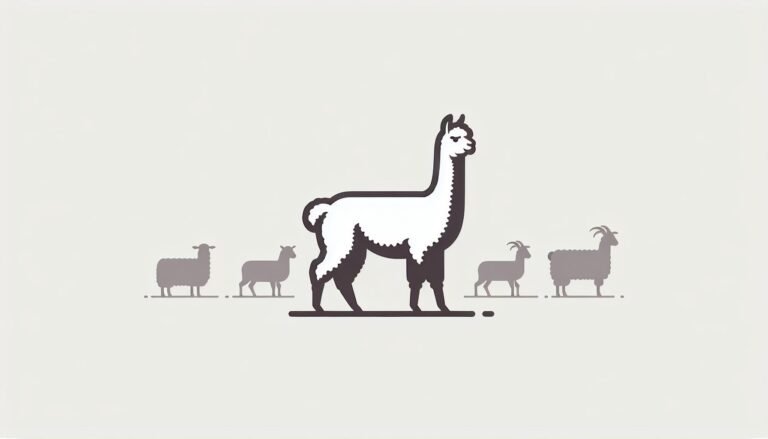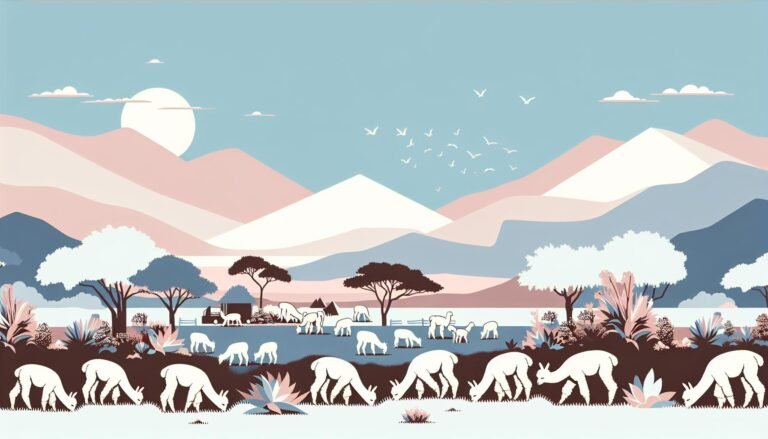Thriving Alpacas in Australia: An Unexpected Boon to the Ecosystem
Ever wondered if alpacas call Australia home? You’re not alone. It’s a question that’s piqued the curiosity of many. After all, these adorable creatures with their fluffy coats and gentle nature are native to South America, not the land Down Under.
But here’s a surprising fact: Australia is indeed home to a thriving alpaca population. It’s not just about kangaroos and koalas anymore! Alpacas have found a comfortable niche in Australia’s diverse ecosystem. Let’s dive into the fascinating world of Australian alpacas and discover how they’ve adapted to life on this unique continent.
Key Takeaways
- Alpacas are South-American animals but have found a comfortable niche in Australia’s diverse ecosystem, with a thriving alpaca population in the country.
- Alpacas are exceptionally known for their valuable fleece, which offers warmth, lightness, and comes in a variety of natural colors.
- Alpacas in Australia live primarily on farms or zoos, provide high-quality fleece, and serve as attractions for unique tourist experiences.
- Despite their native habitat being the harsh Andean mountains, alpacas have adapted well to Australia’s diverse ecosystems, showcasing excellent resilience and adaptability.
- Alpacas have also found a role as livestock guardians in Australia, deterring predators and helping to control pest populations effectively.
- Alpaca’s positive impact on Australia’s ecosystem extends to their low-impact grazing habits, their feces acting as a natural fertilizer, and their wool being a renewable commodity.
Overview of alpacas
In the grand scheme of the animal kingdom, alpacas might not be the first creatures that come to mind when thinking about Australian fauna. Initially these creatures call the high Andean mountains of South America their original home. However, don’t let that fool you, alpacas have successfully trotted over to the unique and diverse ecosystem of Australia.
These adorable docile animals belong to the camelid family. They share relations with camels and llamas, yet they’ve sculpted a distinctive niche for themselves. They stand about one meter at the shoulder and can weigh up to 65-75 kg. Alpacas also have a rather distinctive look with their long neck, large eyes, and perky ears.

People are most acquainted with alpacas for their valuable fleece. This covetable commodity is lightweight, soft, and superior to sheep’s wool. It offers warmth without the heaviness. Alpaca fleece comes in a wide variety of natural colors, which increases its appeal in the textile market.
Let’s examine more interesting points about alpacas, their social habits for instance. They are herd animals, that thrive on social interaction. Alpacas communicate using a range of sounds, body language, and even spitting when they’re not happy.
A divergence from their South American roots, alpacas in Australia live primarily on farms or in zoos. They have a life expectancy of 15-20 years. In recent times, alpaca farms have grown increasingly popular in Australia. They serve a variety of purposes from producing high-quality fleece, to offering unique tourist experiences.
Diving into the fascinating world of Australian alpacas not only allows us to understand these unique creatures but also sheds light on Australia’s astonishing ability to house diverse species. The story of alpacas in Australia is truly one of adaptation and survival and their story continues.
Native habitat of alpacas
When we think of alpacas, we naturally associate them with their native South American homelands. These engaging creatures originally hail from the Andean highlands of Peru, Bolivia, and Chile. Imagine them mixing and mingling with other indigenous species, in a habitat high up where the air’s thin and brisk, and panoramic vistas of mountains stretch as far as the eye can see.
These conditions are ideal for alpacas – their specially evolved thick fleece is perfect for the extremes of the Andean climate. Not to forget, they’ve got a knack for navigating the rugged terrain with ease. Yet, it’s their remarkable flexibility and ability to adapt, traits I’ll elaborate on shortly, which have allowed these adorable creatures to flourish far beyond their native borders.
Speaking of alpaca fleece, did you know it’s one of the most treasured natural fibers in the world? Prized by fashion and textile industries worldwide, it’s seen as a luxury thanks to its soft, lightweight, and insulating qualities. The alpacas offer a range of natural colors too, making for appealing and renewable material with minimal processing required.

Now just because alpacas thrive in harsh mountains doesn’t mean they can’t settle and prosper elsewhere. Quite the opposite in fact. Clearly evident from the unexpected flourishing alpaca communities in Australia, these animals have shown an impressive knack for adjustment and survival.
Australia, with its diverse ecosystems, provides an equally conducive habitat for these creatures. They’ve swiftly grown accustomed to the varied climates from the tropical north to the cooler south. There’s plenty of wide-open space in Australia for them to roam freely and safely. Admittedly, it’s nowhere near the Andean peaks’ harsh conditions, yet it’s clear these fluffy Andean ambassadors are doing just fine on Aussie land.
What’s truly fascinating about our furry friends rests in their ability to ubiquitously adapt, confirm their resilience, and wholeheartedly embrace their new homes. Be it South America or Australia, their survival indeed makes an intriguing tale of adaptation and resilience. Our focus here being Australia, let’s delve deeper into how alpacas found their way Down Under.
Alpacas in Australia: An unexpected presence
When you think of Australia, kangaroos, koalas, and wombats might be the first animals that come to mind. Alpacas? Probably not. Yet these South American natives have found a second home in the Land Down Under, proving themselves to be quite the unexpected guests.
Believe it or not, there are over 250,000 alpacas in Australia. That’s enough to populate a small city! The first alpacas arrived in Australia in the mid-1800s, as part of a drive by the British to introduce useful animals to their colonies.
In the table below, you’ll see just how dramatically the alpaca population has grown in Australia:
| Year | Alpaca Population |
|---|---|
| 1850s | a handful |
| 1890s | several hundred |
| 2022 | 250,000 |
Adapting to Australia’s diverse ecosystems wasn’t easy for these Andean natives. But with their resilience and adaptability, alpacas have thrived, coping with everything from sweltering heat to freezing cold.
In Australia, alpacas are not just farm animals. They also play a crucial role in Australian agriculture, acting as livestock guardians and helping control pest populations. Outside of the agricultural sector, alpacas are celebrated for their fine, soft fleece – a product that’s in high demand in the fashion and textile industries.
Indeed, this story of alpacas in Australia is one of surprise, adaptation, and success. As they continue to thrive in a land so different from their native Andes, I can’t help but admire their resilience. These creatures have indeed proven that they can adapt and thrive almost anywhere in the world – including Australia.
How alpacas made their way to Australia
It’s quite a tale, the journey of how alpacas found their new home in Australia. Today we find over 250,000 alpacas thriving in Australia’s diverse ecosystems. But how did these creatures, native to South America, end up on Australian soil? Let’s delve into the history and find out.
The alpaca story begins in the mid-1800s, a challenging era for world travel, with their importation into Australia. Back then, only a small number of these resilient creatures managed to survive the tumultuous voyage from their Andean native lands across the vast Pacific Ocean.
| Year | Number of Alpacas in Australia |
|---|---|
| Mid-1800s | Few (Initial Importation) |
| Present Day | Over 250,000 |
Despite the harsh initial journey, the subsequent generations of alpacas have adapted well. The climates they faced were not all that different from their mountainous origins. Ranging from the temperate south to the tropical north, Australia offered the alpacas a varied landscape that mimics the diverse conditions of their home range in the Andes.

On Australian farms, alpacas found their role as livestock guardians. They’d deter predators such as foxes, helping control pest populations effectively. Their fleece, lauded for its softness and warmth, found high demand in fashion and textile industries.
So, what began as a challenging journey for a small group of alpacas in the mid-19th century, led to an impressively large population of over 250,000 in present-day Australia. The unexpected presence of alpacas in Australia showcases their adaptability and resilience, both in their native Andes and in their new home.
Adaptation of alpacas in Australia
In the mid-19th century, the landscape of Australia was about to change. A small but stalwart group of alpacas had survived the risky voyage from the formidable peaks of the Andes in South America, to land on Australia’s golden shores. Faced with wildly different weather conditions, unfamiliar flora, and a host of new predators, they had to adapt or falter. So, they bravely ventured on this strange terrain. Little did they know, they were here to stay.
Fast forward to today, and these soft-footed creatures have become a staple in Australia’s diverse climates; a shining testament to the alpacas’ admirable adaptability. Fields that would once have only been home to kangaroos and wallabies now bristle with the soft hum of alpacas. From the hot, dry interior to the cool, wet coastal regions, alpacas have made Australia their home.
The primary reason for this successful adaptation lies in their inherent nature. Unlike many ungulates, they’re browsing animals rather than grazing animals. That means they’ll eat small amounts of a wide range of foods rather than large amounts of a few foods. The diversity of Australian plants has allowed alpacas to transition from species they would’ve eaten in the Andes, to totally new types of flora.
Livestock Guardians: The New Role
Not just for their fleece, but alpacas are respected for another intriguing feature of their character. Their inherent wariness and natural caution translate to an actionable defense against livestock predators. They have a knack for spotting danger, and their distinctive alarm call can alert the rest of the herd. Australian farmers have turned this trait to their advantage, employing alpacas as guardian animals to protect their sheep and goats.
The Demand for Alpaca Fleece
Alpaca fleece is highly sought after in the textile and fashion industries for its softness, strength, and warmth. The advent of mechanized shearing in the early 21st century saw alpaca fleece shift from a niche luxury product to a mainstream commodity. In Australia, the demand for alpaca fleece is growing, ensuring these charismatic creatures will continue to dot the Australian landscape for years to come.
Thriving alpaca population in Australia
Delving further into the world of alpacas in Australia, let’s take a look at the thriving alpaca population. This unique, woolly creature isn’t just surviving – it’s thriving in its new continent.
Australia’s alpaca population has seen a remarkable increase in the last few years. I’ve noticed not just the increase in numbers, but also how well alpacas have adapted to Australia’s climates, and they aren’t shy about their preference for the great outdoors.

Their increasing numbers can be attributed to several factors. One of the key things is the animals’ adaptability. Like nature’s true survivors, alpacas are adept at handling the changing climates. Whether it’s the intense summer heat or the icy cold winters, alpacas roll with the punches with ease.
The Australian Alpaca Association reports a rise of over 20% in the population, year on year. A promising sign of growth ensuring that these fuzzy beings become an increasingly common sight in Australian fields!
| Year | Population | % Increase |
|---|---|---|
| 2016 | 175,000 | – |
| 2017 | 210,000 | 20% |
| 2018 | 252,000 | 20% |
| 2019 | 302,400 | 20% |
The alpacas’ dietary versatility has also played a crucial role in their proliferation in Australia. Alpacas eat a wide range of foods, with a particular fondness for grasses. This trait makes them quite sustainable as livestock as they don’t require special feed.
Moreover, they’re fantastic livestock guardians. Using their inherent wariness of predators along with their distinctive alarm calls, they’ve come into their own as protectors of sheep and other potential prey. This bonus feature, coupled with the rise in demand for alpaca fleece in the textile and fashion industries, has given their population a significant push in the right direction.
In my experience, few species can claim a success story as compelling as that of the alpaca in Australia. Riding on their adaptability, usefulness in agriculture, and the fashion world’s penchant for their fleece, alpacas have indeed found a cushy home away from home amongst the kangaroos. Who knows what the future might bring for them, especially given their current upward trajectory?
Alpacas’ role in Australia’s ecosystem
Alpacas have an impressive impact on Australia’s ecosystem. From their low-impact grazing habits to their role as natural fertilizers, these remarkable creatures have proven to be exceedingly beneficial.
Most notably, alpacas’ grazing habits are significantly kinder to the environment compared to other livestock. Unlike cows or sheep, alpacas trim the grass rather than pulling it out by the root, encouraging regrowth and preventing soil erosion. This makes alpacas a prefered choice for maintaining healthy paddocks.
Another intriguing factor to note about alpacas is their feces. Alpaca waste is often referred to as the “black gold of the Andes”. This is due to its high nutrient content, making it an excellent organic fertilizer. Australian farmers have taken advantages of alpaca dung for crop growth, enabling them to produce organic food efficiently.
Moreover, alpacas have shown to be good for the soil. By their natural movement, they help to aerate the soil, promoting water infiltration which is beneficial in dry climates.
| Alpaca Contribution | Explanation |
|---|---|
| Low-impact grazing | Trimming rather than uprooting grass, prevents soil erosion |
| Feces as fertilizer | High nutrient content, good for crops |
| Soil Aeriation | Movement of alpacas promotes water infiltration |
While discussing the environmental benefits, it’s worthwhile to reiterate how the use of alpaca fleece plays into sustaining this balance. The fleece is renewable, biodegradable and requires less energy to process compared to synthetic fibers. It’s an ideal choice for manufacturers looking for a sustainable option.
Given these points, it’s clear to see why alpacas not only fit into but enhance the Australian ecosystem. They bring a unique balance of environmental benefits that make them ideal residents in Australia’s pastoral combo. Their future in this ecosystem looks undoubtedly positive.








Our picks
Alpaca & Wool Felted Sole Inserts: Comfy Upgrade?
Best Alpaca Socks for Hiking: Ultimate Comfort and Durability on Trails
Best Alpaca Halter for Comfort and Control